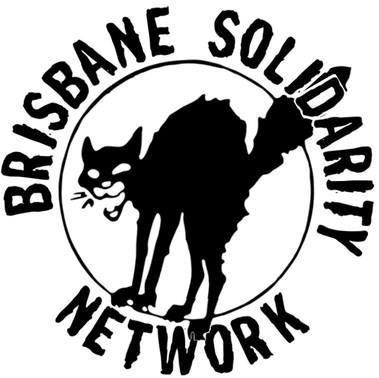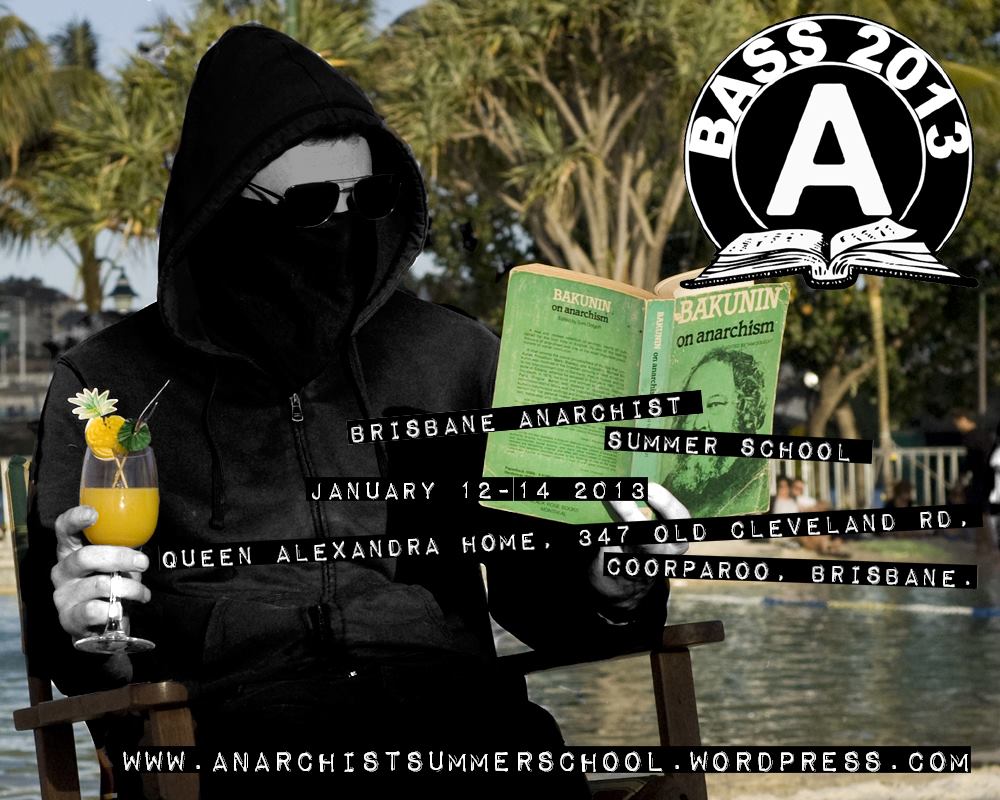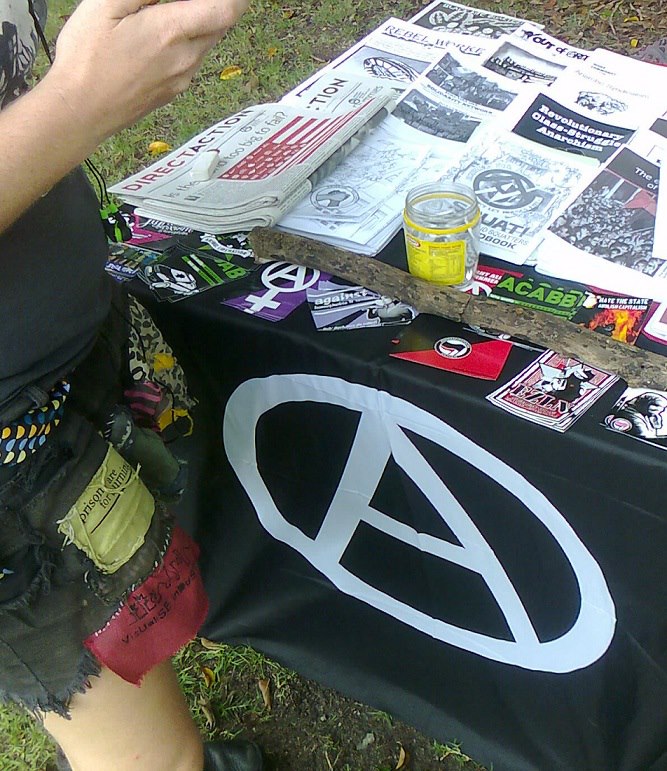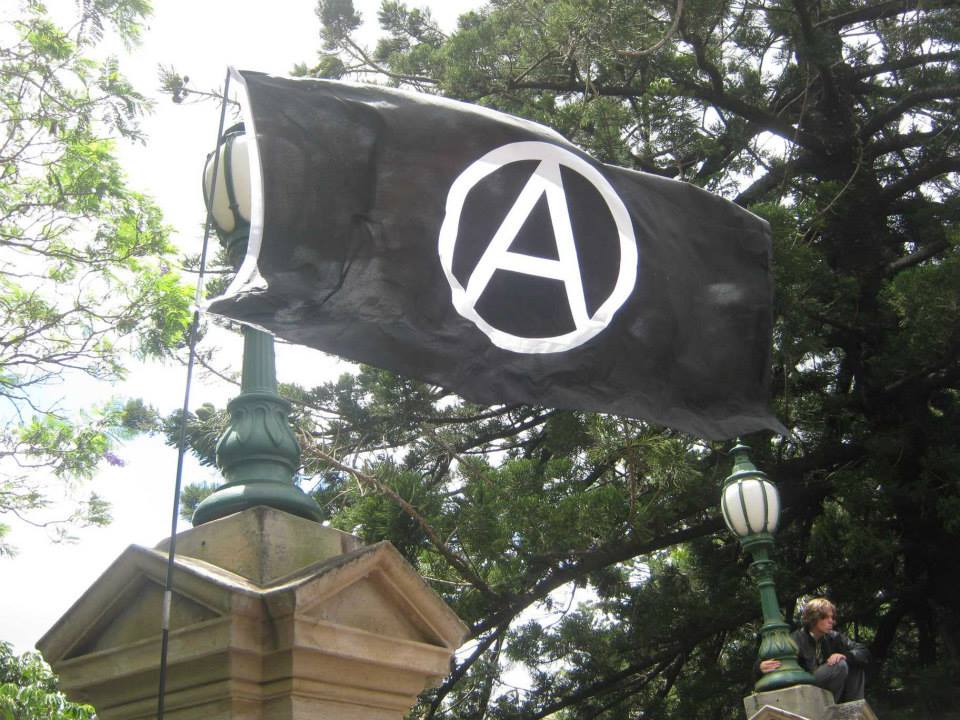
The aspiration for an anarchist federation in Australia is as old as the anarchist movement in Australia itself. Upon its formation in 1886, the Melbourne Anarchist Club announced its intention to “promote the formation of voluntary institutions similar to the Melbourne Anarchist Club throughout Victoria and the neighbouring colonies, and, with their consent, to eventually unite with them forming the Australasian Association of Anarchists.”1 David Andare, one of MAC’s founders, wrote enthusiastically of this prospect to the American individualist anarchist Benjamin Tucker, who received his correspondence with equal excitement. As early as 1888, however, divisions would appear within this young movement, with many moving away from the individualist anarchism espoused by Andare and Tucker in favour of the anarchist communism of Peter Kropotkin and Emma Goldman.2
Since then we have seen the emergence and disappearance of dozens of groups and spaces across Australia. Over the past fifty years federations have been attempted a number of times, in 1975- 1976, 1986, 2007-2008 and 2013-2015, at least to our knowledge. With the exception of 1986, each of the preceding proposals have suggested a synthesist approach, attempting to bring together anarchist groups and individuals regardless of their ideological or tactical approach. The 1975 Federation of Australian Anarchists (FAA) lasted just over a year before the diversity of opinions and ideologies present in the organisation led to its collapse at its 1976 congress. Anarcho-syndicalists would establish their own federation in 1986, and while this federation still exists, it has not in recent years been able to maintain its relevancy and has diminished to a point of invisibility. The more recent 2007-08 attempt and the 2015 Provisional Anarchist Federation brought together groups from Brisbane, Melbourne, Sydney and Perth but both would swiftly vanish.
Attempts have come out of ‘moments’ that inspired confidence in the feasibility of federation. The 1986 formation of the ASF developed as convergence of anarcho-syndicalist groupings in Melbourne and Sydney. 2007-08 came out of the series of summit protests at the time and the success of numerous gatherings such as FLARE in the Void, A Space Outside and Live and Let DIY. 2013-15 also reflects a period of buoyancy in the movement. The proliferation of anarchist collectives across the country, combined with the successful Brisbane Anarchist Summer School, gave rise to a period of optimism that soon dissipated along with many of the groups it included. The period that we currently inhabit should be seen within the context of bitter struggles globally, the rise of hard-right forces, the erosion of the liberal-democratic state, the collapse of the United States’ unipolarity, heightened conflict in the Pacific, the coronavirus and successive natural disasters as climate change worsens. This has led to an internal reexamination among anarchists worldwide of our strategies and tactics as we find the renewed relevance of our ideology bring it to the front lines of struggle.
While we can appreciate calls for anarchist unity, however, the experience of synthesist groups leads me to believe that organisations need to value internal coherence rather than attempt to collect as many individuals as possible. Groups that tend towards the latter in Australia tend to have an extremely limited shelf life as opposed to groups that remain faithful to a clearly defined set of guidelines. The desire for large, ponderous groups such as Unite, which based their politics on bringing together diverse coalitions of leftists, is evaporating in favour of forming more tight-knit militant formations. Constructing a federation of groups and individuals that do not have shared principles, or even ideologies, has emerged to us in the course of struggle as a pointless exercise.
The 1975 Organisational Platform of the Federation of Australian Anarchists, a title clearly inspired by Delo Truda, came close to this conclusion in noting that, “the central task of the revolutionary movement is the creation of flexible democratic organisation, united by common programme, strategy and analysis rather than by subordination to a common centre; uncompromised by automatic support for external power-political interests, and having sections capable both of independent action and of unity on a joint action programme with other sections.”3
Unfortunately this simply wasn’t reflected in reality. Before the formalisation of the FAA, the Self-Management Group had predicted that the “lack of unity and coherence within regional groups would be unfavourable to the realisation of a national strategy.”4 This would be proven correct almost immediately, when disagreements between the anarcho-syndicalist, individualist-egoist and anarcha-feminist currents within the organisation erupted at the FAA’s first Congress in 1976. An intense (and likely justified) rejection by anarcha-feminists of the ‘male politics’ that permeated anarchist politics at the time had led to the exclusion of men from the 1975 Anarcho-Feminist Conference, leading to resentment at the Congress. This was further exacerbated by the predominance of university-based anarchist collectives that felt themselves to have little in common with the more workerist/syndicalist elements. Various factors would lead to the implosion of the Congress and the re-fragmentation of the movement.5
A concentrated attempt was made in the aftermath of this conference to establish a more limited federation exclusive to those within the anarcho-syndicalist tradition. From 1975 on, various anarcho-syndicalist organisations would begin to coalesce in Sydney and Melbourne, influenced by exiled anarcho-syndicalists from Bulgaria and Spain. In 1986 the Rebel Worker Group in Sydney and the Melbourne Anarcho-Syndicalist Group, itself a merger of the Spanish CNT in exile and the Melbourne branch of the IWW, agreed to form the Anarcho-Syndicalist Federation. The ASF in its early years had some major successes, absorbing the Public Transport Workers Association in 1987 and was admitted as the Australian section of the International Workers Association in 1988, an affiliation it continues to pride itself on today.6 In more recent times, however, the ASF has struggled to maintain its relevancy. Along with some successes in forming links with other anarcho-syndicalist groups in Indonesia and Bangladesh, the ASF’s activities today are largely limited to pickets in solidarity with its international affiliates and its numbers domestically have dwindled to a small handful.

To segue briefly, it is worth reviewing why I don’t believe it worthwhile to simply merge our own efforts with those of the ASF, concentrating purely on the ideological side of things. Within the platformist tradition, we find anarcho-syndicalism to be insufficient, viewing, in the Platform’s words, anarchism and syndicalism as belonging “on two different planes. Whereas communism, that is to say a society of free workers, is the goal of the anarchist struggle — syndicalism, that is the movement of revolutionary workers in their occupations, is only one of the forms of revolutionary class struggle.”7 As the Workers Solidarity Movement in Ireland noted in 2003, “In our view syndicalism (at least historically) has failed to address the issue of political power. We believe that to make a revolution it isn’t sufficient that workers just seize their workplaces and the land. They must be organized right across communities and workplaces to smash state power and replace it with workers’ councils. This requires revolutionary anarcho-communist organizations dedicated to this goal.” 8
Returning to the topic at hand, the next two attempts (2007, 2013) at a nationwide federation were again synthesist in nature. By this time, platformist politics had finally asserted themselves with the formation of Anarchist Affinity, which would later become Collective Action. AA, while not hostile to the idea of federation, responded to the 2013 proposal with the statement that “Anarchist Affinity believes that a specifically anarchist political organisation must be built if we are to seriously advance anarchist ideas and advance the struggle against capitalism, the state and all forms of oppression. We believe that anarchist organisations are most effective when built on a shared political understanding (theoretical unity), a common strategy (tactical unity) and united by a collective responsibility to their implementation.”9 They went on to state that “the kind of federation we advocate will require the active participation of multiple functioning and healthy anarchist groups, with both the desire and preparedness to achieve greater theoretical unity, as well as the resources in labour and money required to meaningfully pursue common strategy.” Conscious that “other groups participating in the conference favour a much looser conception of federation, with more limited organisational goals”10, AA opted to abstain from the rest of the discussions taking place at the time.
It is along these lines that it is worth considering how a new approach towards federation can be taken. Aware of the need for a new approach in Australia, it is my belief that a turn towards the principles proposed in Delo Truda’s Organisational Platform of the General Union of Anarchists and later elaborated by the especifist current in Uruguay is necessary. The fundamental tenets here remain unity of theory and strategy, tactical homogeneity, a federal structure and internal collective responsibility for militant activities. An elaboration of each of these can be found in The Platform by the Worker’s Solidarity Network.11
This brings us to the question of why we should desire federation. This was a source of some confusion for the various attempts in the past. The 2007 proposal opened with the lament that there was an “underlying sense of isolation from broader anarchist activity” and that this constituted a “severe barrier on our ability to maintain effective struggle or to even propagate a revolutionary, anarchist politics on a larger-scale”12. The Mutiny Collective believed that “(o)verall the aim of the federation seems to be about promoting solidarity with anarchists from all parts of the region, and opening up communication about anarchist practice.”13 The 2008 Northcote conference call-out suggested, “improved solidarity work when individuals and collectives face state repression; better support for anarchist spaces that already exist & the production of a regular regional publication; the development of greater momentum & support when collectives around the region are organising around similar issues.”14
What we find here and in many of the message boards and statements circulating in the period from 2007-2015 is a shared feeling that the geographic isolation of population centres formed the primary obstacle to the construction of a nationwide anarchist movement. What I would suggest here is that this was symptomatic of the anarchist movement’s failure over the past three decades to engage with emerging technologies. The shrinkage of time and space in our era overcomes this problem, particularly now that the Coronavirus has normalised video conferencing technology.
The real need for a federation, in my view, has already been assessed within the platformist/especifist tradition: “Anarchists have played important roles in many revolutions, but have invariably been defeated. One reason for this history of defeat is the failure of the anarchist revolutionary minority to organize itself into a distinct political organization. A democratic federation could develop a coherent analysis and program, could coordinate the activities of members, and could spread its ideas through its literature. It would not include all anarchists, but only those who agreed with its program. It would not be a ‘party’, since it does not aim at ruling a state.”15
Crucially, it would act to establish the conditions of our engagement with social struggles. As the FAU’s Huerta Grande notes: “To propose a program, we must know the economic, political and ideological reality of our country. The same is necessary in order to create a political line that is sufficiently clear and concrete. If we have insufficient or incorrect knowledge, we will not have a program but only a very general line, difficult to implement at all the places the party is inserted. If there is no clear line, there is no efficient political practice. The political will of the party then runs the risk of getting diluted, “voluntarism” in action ends up becoming just doing whatever comes up out of sheer good will, but does not determine the outcome of events, based on its inaccurate previsualization. We are determined by them [the events] and by them we act spontaneously.”16
In short, we do not want a federation that serves to simply ‘improve solidarity’ or ‘open up communication’, though these are certainly features of any federated organisation. Rather, we should see federation as a means to collectively assess the realities facing us and develop theories and strategies to confront them in a consistent and meaningful way. “Theory aims for the elaboration of conceptual instruments used to think rigorously and profoundly understand the concrete reality. It is in this sense, that we can refer to theory as an equivalent to a science.”17

APPENDIX
Notes on the practical orientation of a federation.
A federation would serve as central ideological and strategic point of reference, allowing member organisations to work within a unifying framework and coordinate their activities. It would be based on an agreement around a key document similar to the Anarkismo Editorial Statement and have an overall set of procedures that the organisations affiliated to it would be bound to. Affiliated organisations would be free to maintain their own independent character, policies and procedures as long as they did not conflict with those of the Federation. If an affiliated group decided to endorse and participate in a political party’s electoral campaign, for example, that would be in contravention to the Federation’s principles and would serve as grounds for suspension.
It is easy to talk about the ‘can nots’ of a federation, however, than to describe its benefits. In my own research into federation attempts in the past, there hasn’t been a great deal of discussion concerning that and they generally haven’t gone beyond ‘it would increase cooperation’. Below I have compiled a list of projects and benefits that could come about as a result of Federation.
-A theoretical journal that would serve as a discussion point for advancing specific anarchism in the Australian context. This would be the public point of access to the Federation’s theoretical advancements.
-An internal theoretical and strategic bulletin between the various organisations affiliated with the Federation where ideas and disagreements could get thrashed out. This could exist in an online or a physical format and would allow members to present strategies and theories that they suggest could advance the Federation’s general praxis and facilitate discussion. This would also bolster the ideological and theoretical unity of the Federation.
-A newsletter that could be distributed to the public at demonstrations, pickets and other events containing the Federation’s analysis of events in Australia and around the world as well as news from the various affiliates. This would be for many members of the public their first introduction to anarchism and the Federation’s politics and ideas. It would also not only help give the affiliate organisations common talking points but bring them into greater alignment ideologically and strategically, with articles being proposed for this publication being discussed on the Federation’s online internal platform. It would of course not take the place of the various affiliate’s own publications. This is common practice in Anarkismo affiliated groups.
-A basis for interaction with other groups that exist on a national scale, including the trade union and socialist movements. This would allow affiliated organisations to present a unified body and give them a common voice with which they can confront issues that affect Australia as a whole.
-Sponsorship of new branches. Where reading groups and small collectives appear, a Federation could offer guidance and sponsorship. This would mean sending them pre-prepared sets of readings and sending members to their location to meet with them and explain the Federation’s foundational principles (platformism/specificism). Sending members in person would also serve to allow the Federation to gauge that group’s level of political coherence, activity, commitment and maturity.
This would help to bring more organisations into the Federation and attempt to ensure their longevity and expansion. There are plenty of groups that have appeared around the country but have disappeared altogether (e.g. Black Swan Adelaide) or have slipped into a charity model that may have benefited from some guidance. Where the Federation felt a group wasn’t suitable for inclusion or that group remained unconvinced by the Federation’s principles, this guidance/sponsorship would hopefully transition to a lasting friendship, with the door open to further collaboration in the future.
-A common resource pool, perhaps in the form of a monthly donation made by each organisation, according to their own ability to do so, and occasional fundraisers that would facilitate conferences, assist expenses for Federation-related travel, subsidise bond money for establishing new centres and so on. In terms of travel, the Federation could subsidise airline tickets if it wanted to send representatives to a conference in Europe or South America or if it wanted to send someone to speak with a collective emerging in a new area.
-It would give members who were changing cities the opportunity to easily transfer to other groups. Some groups have a lengthy trial membership stage before candidates are granted full voting rights, for example. A Federation would allow a streamlining of this process, allowing full members of the various groups to immerse themselves immediately in their new city. If someone moved to an area without Federation presence, the Federation could assist that person to build their own group, by sending resources and sponsoring (in a realistic, transparent and accountable manner) expenses that may occur.
-An annual or biannual conference hosted in different cities that would have both public and internal sessions, not dissimilar to Socialist Alternative’s Marxism and Socialism conferences. This would give an opportunity for unaffiliated anarchist individuals and groups as well as the general public an opportunity to engage with the Federation’s politics and perspectives while showcasing the Federation itself. This would serve to build the Federation’s prestige and bring in people who have not yet been convinced of its politics.
On the final day of the conference, the affiliate organisations would meet in a private session to discuss matters pertaining exclusively to the Federation’s operation – including tactical and theoretical points, the entry of new organisations, international relations and any grievances that may exist and can’t be resolved in an online format. This would further allow individual members of the Federation the opportunity to become better acquainted with one another and give everybody something to look forward to every year. The Brisbane Anarchist Summer School in 2013 showed that a conference can be organised by even a relatively small group and still be widely successful, with hundreds of anarchists from around the country in attendance.
-Internationally the Federation would serve as the chief means by which affiliate organisations would interact with other groups within our tradition internationally, including but not limited to the organisations that have declared their support for the Anarkismo Editiorial Statement. It would also help to guide interaction with other anarchist and non-anarchist groups that affiliates wish to interact with. This is of course not to say that affiliate groups wouldn’t be free to pursue their own alliances, but the involvement of the Federation as a whole would allow a greater level of participation and cooperation.
If down the track, for example, where specific groups begin to form in the Asia Pacific, the possibility of the Federation opens the building of relations and sharing resources with neighbouring countries, helping them to gather strength and perhaps even work towards a regional platform for cooperation. Given the geographic, linguistic and cultural proximity with Aotearoa there are strong possibilities for a cross-Tasman federation. There is already a long history of work with Indonesian and Filipino groups that in turn may eventually yield opportunities in those countries as well.
REFERENCES
1 https://www.katesharpleylibrary.net/jdfpdj
2 Tom Goyens 2018, Anarchy at the Antipodes: Australian Anarchists and their American Connections, Salisbury University, Maryland, p. 4-5.
3 http://www.takver.com/history/aia/aia00037.htm
5 http://www.takver.com/history/aia/aia00045.htm
6 https://asf-iwa.org.au/history/
7 https://libcom.org/library/platform-3
8 https://freedomnews.org.uk/2021/12/09/ireland-a-farewell-to-the-workers-solidarity-movement/
9 https://slackbastard.anarchobase.com/?p=33968
10 Ibid.
11 https://theanarchistlibrary.org/library/workers-solidarity-movement-the-platform
12 https://afederation.wordpress.com/2007/12/07/hello-world/#comments
13 https://afederation.wordpress.com/responses/mutiny/
14 https://slackbastard.anarchobase.com/?p=1018
15 https://theanarchistlibrary.org/library/wayne-price-revolutionary-class-struggle-anarchism 16 https://zabalazabooks.net/2021/03/19/theory-ideology-and-political-practice-the-faus-huerta-grande/ 17 Ibid




